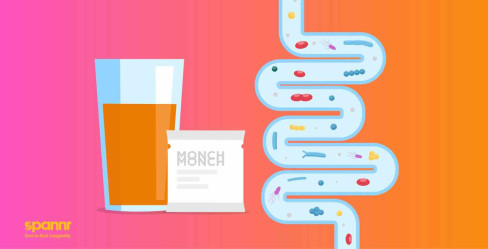Monch Monch for Longevity? (Carbs are Back!)

“Oh my God,” her jaw dropped.
“I would eat noodles again for every meal,” my Korean mother exclaimed when I told her about Monch Monch.
I didn’t blame her. Noodles are delicious and a staple of many Asian diets; some of my favorite memories as a kid were of my mom taking me to the local Korean markets in Seoul to enjoy a warm bowl of noodle soup in the sub-freezing winter.
However, as fond as my childhood memories may be, the disappointing truth about noodles is that they also spike your glucose, a function associated with more insulin, more inflammation, and higher mortality. For those who are diabetic or simply conscious about their health, you either look for modern-day alternatives (which never 100% hit the spot the way those delicious gluten-filled noodles do) or swear off noodles entirely.
Maybe you no longer have to settle.
With the advent of Monch Monch, “the microsponge that absorbs calories,” you may be able to block the absorption of sugars from noodles (and other delicious carbs), reduce the calories absorbed by your body, and feed your gut with the fiber it needs to function optimally.
What is Monch Monch?
Monch Monch is a colorless, odorless, and tasteless powder that you can add to non-water-based food (even ultra-processed food) in order to restore fiber levels, reduce absorption of calories, and minimize the insulin and glucose spikes from consuming food. On a microscopic level, Monch Monch is a microcellulose (insoluble fiber) sponge that’s seven microns in diameter (slightly larger than a red blood cell).
Monch Monch is the first product launched by BioLumen, a nutritional technology company founded by Paolo Costa, CEO, and co-founder and Chief Medical Officer, Dr. Robert Lustig, who serves as an emeritus professor of pediatrics at the University of California, San Francisco.
Originally a materials science engineer, Paolo had been working on this product for 14 years, ever since he grudgingly munched on another junk-laden snack on his flight from the US to Italy. As the flight attendant passed out highly processed snacks, Paolo battled the familiar internal conflict of being hungry while not having great options to choose from. As he weighed his options, he found himself wondering if there was a way to coat his meal in something that would make it consumable, without having to suffer the side effects of eating highly processed food.
It was then that the idea for Monch Monch was born.
How does Monch Monch work?
A supplement created from real food that absorbs calories, blocks sugars from turning into fat, and minimizes the glucose spike from food — can it be real?
If you’re like I was when I first learned about Monch Monch, you’re thinking, “I don’t believe it – tell me more.”
So what’s the science behind how Monch Monch works?
As you digest Monch Monch, it expands 70 fold in the stomach, which gives you a sense of fullness. The nooks and crannies of the sponge have a proprietary blend of hydrogels (soluble fiber), which soak up the glucose, fructose, sucrose, and simple starches in the first part of your intestine, making them unavailable for early absorption.
Effectively, this minimizes the spike in blood glucose and insulin that would normally happen if you ate food without Monch Monch. Additionally, because fructose doesn’t reach the liver, it also isn’t turned into fat.
Once the food and Monch Monch mix passes into the second part of the small intestine, the bacteria of the microbiome digest and metabolize the fiber in the Monch Monch, which generates anti-inflammatory and health-boosting short-chain fatty acids.
TLDR; Monch Monch replaces the fiber missing in food and blocks sugar absorption, effectively converting processed food into real food and providing the plethora of health benefits and requirements that only fiber can provide.
Is Monch Monch just another fiber supplement?
You might be thinking, “Oh, I need more fiber? I’ll just take Metamucil.”
However, it’s not that simple. There are numerous fiber supplements on the market, but few achieve all the benefits Monch Monch does.
One thing Monch Monch has been able to do that other fiber supplements haven’t is combine soluble and insoluble fiber together – most fiber supplements only contain one and not both.
Fiber in real food contains both insoluble and soluble fiber, and they perform different jobs to support your gut health and absorption of nutrients. As Lustig explains in his book Metabolical: The Lure and the Lies of Processed Food, Nutrition, and Modern Medicine, insoluble fiber creates a latticework on the inside of the small intestine and the soluble fiber plugs the holes in the lattice. This combined matrix protects the body against metabolic syndrome by protecting the liver and feeding the gut.
Part of Monch Monch’s proprietary formula is how they’ve been able to successfully combine the two.
What is real food?!
Let’s back up for a minute. We’re talking about the ails of sugar, how wonderful fiber is, and how terrible processed foods are, but some of this knowledge may not be as obvious as you might think.
For starters, we all know we’re supposed to “eat clean,” and although that sounds like a mantra we can all get on board with, most of us don’t know what that really means. One person’s version of “eating clean” is being a vegan, while another person’s version is cutting out all carbs. So what gives?
Michael Pollan, best-selling author of In Defense of Food: An Eater's Manifesto, addresses the debate of what to eat very simply, “Eat food. Not too much. Mostly plants.”
That’s a good start. In Metabolical, Lustig takes it one step further and specifies what foods qualify as healthy versus unhealthy, “1) Protect the liver, 2) Feed the gut.” He explains that foods that satisfy both these requirements are good for you and those that satisfy neither are essentially poison.
“Only items that meet both of these criteria qualify as Real Food, i.e., that hasn’t been stripped of its beneficial properties and sprinkled with toxins that will hasten our demise.”
This is Lustig’s beef with ultra-processed foods: they tax the liver, they starve the gut, and they ultimately contribute to an unhealthy and shortened life. By incorporating Monch Monch as a daily supplement with meals, one can retrieve the original health benefits ultra-processed foods had before they were processed.
As a quick aside, there’s a difference between ultra-processed foods and processed foods.
Food processing involves any technique that modifies raw food for storage or consumption – even heating your food is considered food processing, so it’s relatively unavoidable, making processed food a wide spectrum of foods. Ultra-processed foods, on the other hand, are designed to last longer, be more convenient, and have higher levels of sugar and fat to be more palatable and, let’s face it, addictive.
Why not just eat real food instead?
Why does Monch Monch focus on digesting and maximizing the nutrients in ultra-processed foods? Why doesn’t Lustig simply recommend eating real foods?
He does. In Metabolical, he makes the case that food is the only way we can change the physiological processes in our bodies to improve our health. He goes as far as to argue that if we continue to rely on processed foods and drugs to resolve symptoms, we’ll never escape the chronic diseases that are becoming increasingly rampant in our day and age.
“When you look carefully at the science of these eight [subcellular pathologies that underlie all chronic conditions], you realize that none are druggable, which is why they don’t respond to our current medications, and why people keep getting sicker despite the doctors’ best efforts. But they are all foodable. Despite the billions of dollars poured into pharmaceutical research, no drug can fix or treat any of these eight pathologies, because drugs are not nutrients. Only Real Food works.”
The world needs processed food
But, Lustig is also a pragmatist who realizes ultra-processed food isn’t going away any time soon.
“I know ultra-processed food is not going away. And I’m not even sure we want it to go away, because we have to feed 10 billion people by the year 2050, and we won’t have enough land or ocean to do so. But we must mitigate the health consequences of ultra processed food consumption, because healthcare spending is now 20% of the GDP, and diet-related diseases are 75% of that. Given that the food industry makes $1.6 trillion annually, and we spend $1.9 trillion annually cleaning up their mess, that’s not sustainable. Which is why healthcare is imploding. It's simple: you can pay the farmer or you can pay the doctor.”
No sane person would recommend eating ultra-processed food over real food; however, if we aren’t able to feed billions of people in the future without processed food, Monch Monch is here to make the best of the worst.
Who is Monch Monch for?
Lustig explained the three main demographics Monch Monch caters to:
Biohackers: This group buys dietary supplements, wears continuous glucose monitors, and does whatever they can to “hack” their system to improve health and longevity. They want to keep their blood glucose as low and as consistent as possible, and using Monch Monch would help them mitigate their glucose spikes.
Serial dieters: The second group would be the serial dieters who have tried every diet under the sun, but for whatever reason, nothing seems to work. The reason sometimes is because everything they’re eating is overly processed, whether it’s due to an attachment to certain processed foods or simply relying on convenient foods to support their fast-paced lifestyle. Because Monch Monch gives you a sense of fullness, this can also help serial dieters who may struggle with uncontrollable appetites.
Existing metabolic health issues: The last group consists of people who are already struggling with some variation of metabolic syndrome, such as diabetes. BioLumen continues to perform clinical studies on Monch Monch in different populations, including diabetics, but although they await more concrete data, the results so far have been promising.
BioLumen conducted a study using continuous glucose monitors on 40 participants, examining how Monch Monch affected glycemic response while consuming a candy bar. The results showed “a 20 mg/dl reduction in peak glucose levels, a quicker return to baseline levels, and no development of reactive hypoglycemia. This suggests that Monch Monch may play a role in improving glycemic control, even when enjoying indulgent treats.”
The born skeptic becomes a believer
When Lustig was asked to come aboard as the Chief Medical Officer, he took his responsibility seriously.
The first tenet as a doctor is to do no harm, and in a sea of confusing and questionably effective (let alone healthy) supplements, Lustig didn’t want to contribute to the upswing of chronic illness he was seeing in healthcare. In fact, Monch Monch would have launched a few years earlier if it wasn’t for Lustig’s insistence that they produce the studies that supported the health benefits and, more importantly, confirmed there were no negative side effects associated with taking it.
For someone who has spoken and written at length about processed food, chronic disease, and our failed healthcare paradigm, Lustig affirms the science behind Monch Monch is undeniable -- it's a proven real food-based supplement that can help offset metabolic risk from any food.
About the Author
Sign Up For Our Newsletter
Weekly insights into the future of longevity
